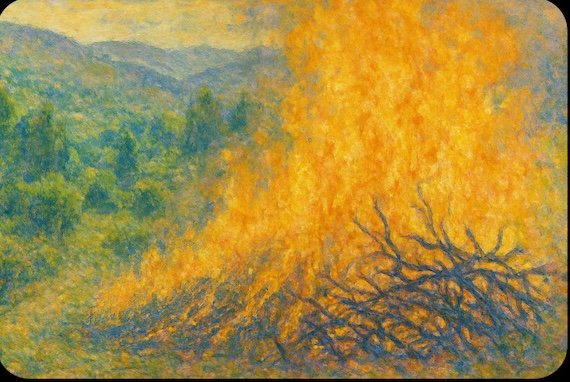Ann Arbor (Informed Comment) – The massive wildfires that broke out near Jerusalem and which threatened residents of the city appear to have been largely extinguished, though some embers have reportedly blazed back up.
The fires have provoked a vicious blame game inside Israel. The Jerusalem Post argued that the current extremist government cut funding for the firefighting service in order to give more money to Ultra-Orthodox Jews, one of its constituencies. Haaretz blamed Minister of National Security Itamar Ben-Gvir for not following through on the order of fire-fighting helicopters initiated in 2022 before the present government came to power, characterizing his leadership as clownish. Ben-Gvir is the Israel equivalent of a Neo-Nazi, however, so that accusation is an insult to clowns.
The son of Israeli Prime Minister Benjamin Netanyahu, Yair, attempted to blame the Israeli left for sabotage in setting the fires. But the prime minister himself appears to want to fix the blame on Palestinian-Israelis, though there is no proof they were involved. Ironically, some Palestinians themselves intimated on social media that Israeli squatters conducting sabotage against Palestinians set fires that spiraled out of control.
Whatever the proximate cause of these wildfires, the actual villain of the piece is climate breakdown, caused by human beings spewing billions of metric tons of carbon dioxide into the atmosphere every year, by burning gasoline, coal and fossil gas. The average temperature of the earth’s surface is heating up twice as fast in the Middle East as the global average, producing extra aridity and heat that are conducive to wildfires.
A few years ago an Israeli commission report leaked to the press concluded that “the climate crisis will lead to an increase in unstoppable massive wildfires in Israel.” The Commission warned, “A significant increase in wildfires is expected throughout the Mediterranean basin. Therefore, reliance on international assistance may prove to be impractical.” That is, ordinarily Greece or Italy might help in such situations, but they are facing their own wildfire menace.
The Commission warned that Israeli firefighting capacity could be overwhelmed by the climate breakdown. Commission head Nissim Twito told Haaretz, “The great danger we will have to face in coming years is an increase in the intensity and number of massive wildfires. We are on borrowed time and the question is not will it come, but when.”
Another problem is the planting of pine forests, mostly for recreation and tourism rather than for lumber, pursued by Israeli immigrants from Europe who did not appreciate the local ecology.

“Wildfire,” Digital, ChatGPt, 2025
Political Scientist Ghada Sasa argues in her “Oppressive pines: Uprooting Israeli green colonialism and implanting Palestinian A’wna,” Political Studies, Volume 43, Issue 2 (2022) that Israeli colonialists planted pine forests, which are especially vulnerable to wildfires, displacing the olive and fruit trees that had been cultivated by indigenous Palestinian farmers. Olive and citrus trees and grape vines are fire resistant, since they store water and are leafy. They also act as firebreaks to wildfires.
Israeli squatters in the Palestinian West Bank are estimated to have destroyed as many as one million olive trees, in a bid to deprive indigenous Palestinians of their livelihoods. Sometimes they have managed to burn the orchards. Olives are resistant to wildfires, but they will burn if people throw accelerants on them and specifically set fire to them.
Professor Sasa writes,
- “Israel may be completely converting Palestine into a desert, by uprooting its families, and stripping it of vegetation and water (Pessah, 2016). It was not until after 1948 that 90% of Israeli forests were grown, but non-Indigenous species constitute 89% of them (Pappé, 2006: 227). The majority of trees JNF boasts having planted, since nearly its inception, were non-Native evergreens (Pappé, 2006: 227), which devastated both local communities and ecosystems (Lorber, 2012). For instance, animals belonging to Palestinian shepherds could not feed on greenery, after it was acidified by the shedding of Israeli pine needles (Lorber, 2012). Besides, as evidenced by the most critical wildfire Israel experienced, in 2010, these are highly flammable trees (Lorber, 2012). Israeli planted forests have even been termed ‘pine deserts’, by environmentalists, due to the ‘biological paucity’ they have caused (Amir and Rechtman, 2006: 43–44). Furthermore, as Nathan (2005: 135) notes, Indigenous carob and fruit trees, including more than 800,000 olive trees, since only 1967, were uprooted by Israel (Visualizing Palestine, 2013). In Israeli-occupied Palestine, 80% of the responsibility for a staggering 23% reduction in its forests, which occurred from 1971 to 1999, fell on Israeli colonialism and militarism (Ghattas et al., 2005: 135). Only in 2001, the Israeli state uprooted 670,000 fruit and forestry trees there (Ghattas et al., 2005: 135).”
So part of the problem here is that European settler-colonialists in Palestine favored the pine forests of their homelands in Europe, and planted en masse precisely the wrong kind of tree for an increasingly arid Middle East that is prone to wildfires. Israelis need to listen to indigenous Palestinians about the need instead for olive, orange, grape and other cultivation that combats the wildfires. They need to listen and make use of this indigenous knowledge instead of setting fire to orchards and trying to ethnically cleanse another seven million people.


 © 2025 All Rights Reserved
© 2025 All Rights Reserved